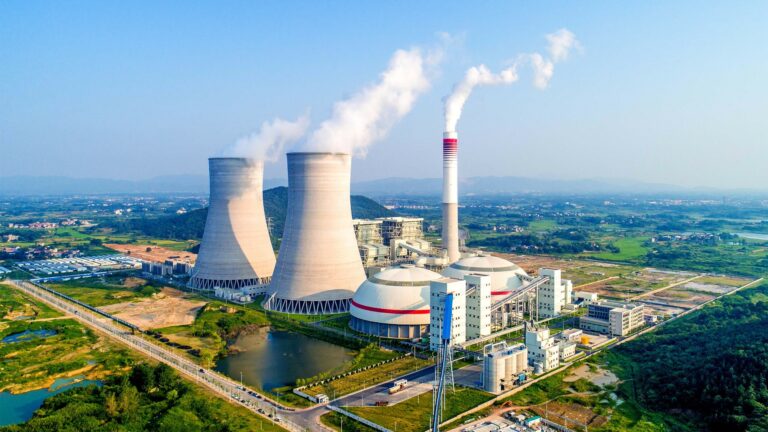- IPR Intelligence
- Back to Main Page
Is 1.5C Still achievable? Straight pathway or tackling Overshoot?
There are many pathways to an achievable 1.5C outcome by 2100. IPR believes that the most likely pathway includes a temperature overshoot that leads to substantial Carbon Removals unless Policy makers takes drastic action now, particularly in the developing world, to crush emissions.
Recent commentary from the IPCC AR6 Summary Report has increased focus on a topic that IPR has been addressing since its 2018 launch: Will there be a temperature Overshoot of the 1.5C Paris Agreement target by 2100? Taking into account detailed and integrated Energy and Land Use analysis, in the IPR Forecast Policy Scenario (1.8C FPS) both its original 2019 inception and subsequent 2021 update, the FPS has forecast a policy response that could deliver a 1.8C outcome by 2100 at a 50% probability.
The IPR also explored the Overshoot being addressed by further ‘Carbon Removals’, which includes Negative Emissions Technologies (NETs), to reach a 1.5C outcome. Subject to further strong policy development of Removals, we believe that a 1.5C outcome is feasible. But is it forecastable as yet? The US IRA already contains important elements. The more direct route, as the IPCC has called for, is that current climate policy must massively accelerate, particularly in the developing world, in the run up to the 2025 Paris Ratchet, as per the 1.5C IPR Required Policy Scenario (RPS). Certainly, the cost of relying on Removals is greater than strong action on underlying demand policies, but the political economy seems reluctant to deliver that policy acceleration.
Carbon Removals have proven controversial as an idea for many years. Nature Based Solutions (NBS) are seen as cheap but based on forestry have been hard to pull off at a quality scale. Technology-based solutions i.e., those based on carbon capture and storage (CCS) – Bioenergy CCS and Direct Air CCS (BECCS & DACCS)– are criticised as expensive, not demonstrated at scale, and an excuse for fossil fuel companies to continue producing and energy-intensive sectors to continue emitting. But with Overshoot looming quite possibly this decade, the recent debate has moved on to how to use Removals in a constructive way. Carbon Tracker has suggested removals be ‘reserved’ to decarbonise hard to abate sectors such as industry, and then ultimately to address Overshoot, rather than be used to justify continued investment into new fossil fuel production.
As the IPCC points out (see below), waiting for deployment of any carbon reducing technology increases the risk of more significant Overshoot and its associated dangers (including as IPCC scientist warn, irreversible impacts). Hence, the earlier Removals are deployed, the less Overshoot builds up and the closer we approach Overshoot, the easier it is to see that Removals are addressing it.
In effect, given political and economic realities, we see it as ‘inevitable policy’ that Carbon Removals are encouraged to be deployed at significantly higher levels of scale if the world commits to achieve a 1.5C outcome. Starting the development at scale now in hard to abate sectors and the land system where it is needed anyway would mean that by the 2030s more significant Overshoot could be tackled more aggressively as it develops.
From a political economy aspect, Direct Air Capture (DACCS) could play an interesting role, even though it is currently expensive. It can offset carbon from distributed sources, even ‘historically ‘. The OECD has been reluctant to transfer significant amounts of capital to the developing world to tackle climate. The ‘North South’ finance issue remains a problem. The OECD, taking responsibility for its historic emissions (and the fact it has ‘outsourced’ emission intensive industries to the non-OECD) by deploying DACCS as a policy tool, would be a more direct approach directly under its control and potentially justify the cost. China given its size of historic and prospective emissions should also consider such a program. This certainly falls under a ‘reserved for Overshoot’ category. And addresses ‘equity’ between North-South.
Investors can play a role in this development. Nature Based Solutions are the most obvious. But deploying capital to develop some of the more technology-based solutions and as discussed above their role in net zero target setting is an area we will be exploring further later this year.
This post looks at IPR work in the following structure:
- Net Zero does not by default equate to 1.5C – it’s how the pathway evolves around that which determines the temperature outcome. In 2020 IPR published ‘Pathways to Net Zero‘ which examined the architecture of scenario cohorts around a Net Zero 2050 pivot and different temperature outcomes including a 1.5C. This illustrates the possibility of overshooting the 1.5C temperature and returning to it using Carbon Removals by 2100.
- The recent IPCC AR6 has raised the issue of Overshoot, showing the majority of scenarios have some element of it. They also point out how Overshoot is a sub optimal result entailing dangers and quantify Carbon Removals for various pathways.
- ‘Carbon Removals’ or just ‘Removals’ are growing in common use as shorthand for Carbon Dioxide Removals (CDR) which include Negative Emissions Technologies (NETs). Nature Based Solutions (NBS), Carbon Capture and Storage (CCS), Direct Air Capture (DACCS) and Bioenergy CCS (BECCS) are central.
- IPR, as part of its Forecast Policy Scenario (FPS), forecasts global warming peaking at 1.8C and remain there until 2100. We quantified the necessary Carbon Removals required for FPS to reach 1.5C by the end of the century, which still left the peak, or Overshoot in this context, near 1.8C. So reaching 1.5C requires either significant Carbon Removal scaling beyond what is currently in the forecast or a dramatic mitigation policy acceleration, quantified in our Required Policy Scenario (1.5C RPS).
- The IPR FPS estimates that the OECD reaches Net Zero in 2050 but the non-OECD does not, with China, India and SE Asia having the largest gap. Tackling non-OECD emissions remains the key.
- The policy gaps between the IRP 1.8C FPS and the IPR 1.5C RPS show how the non-OECD dominates by sector and how the Chinese coal fleet and deforestation play a key role. Having policy solutions for these sectors is crucial.
- Including a detailed Land Use analysis as IPR does is crucial to determining any pathway to 1.5C as tackling deforestation and afforestation are crucial, in addition to the broader evolution of land use and particularly meat consumption.
- Time is running out in terms of carbon budgets without significant Removals. For instance, at a 50% probability of achieving 1.5C with no Removals, Net Zero is a steep pathway down to 2044. China and India have Net Zero goals in 2060 & 2070 respectively.
- Policy is waking up to Carbon Removal with the US Inflation Reduction Act providing high incentives for CCS, which remains a central Removals technology. China can tackle CCS in its coal fleet and industry directly. The ‘Powering up Britain’ plan includes a large CCS commitment. In order to believe the type of Removals needed to make FPS into 1.5C by 2100 a great deal more work by policy makers is required.
- In 2020 IPR produced a paper discussing Carbon Removals and set out a possible long-term portfolio of these. In 2023, this work will be expanded to look at the investable universe of carbon removals, as well as a comprehensive update of our forecast.
1. Pathways to Net Zero and 1.5C
In AR5 published in 2015 the IPCC set out illustrative model pathways in terms of carbon budgets to reach Net Zero in 2050 and a 1.5C temperature outcome by 2100 . BECCS and NBS are used as the major Removals. See P1-P4 below:
The only scenario architecture with minimal temperature overshoot would be associated with P1, while low overshoot would be associated with P2; the IEA NZE and the IPR 1.5C RPS would conform to these illustrative pathways. A scenario that takes the IPR 1.8C FPS as a starting point before shifting course to achieve a 1.5C climate objective would conform more towards a P3 scenario where more substantive Carbon Removals are needed especially post 2050. But getting started on this would be needed almost immediately to demonstrate and get ready to deploy at scale. The faster these could be deployed the lower the Overshoot. The more policy encourages the development and deployment of Removals the more these become ‘forecastable’ and scalable.
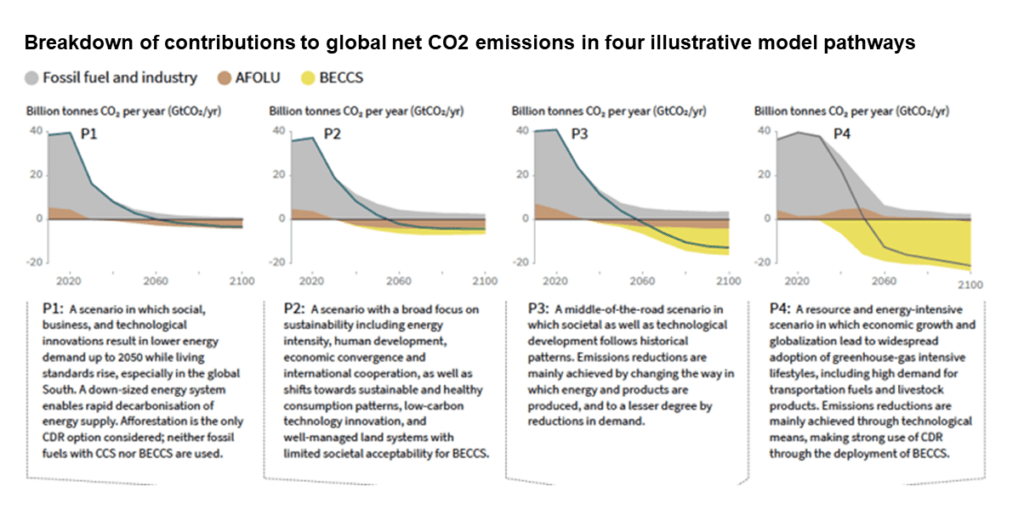
Source: IPCC, 2018: Summary for Policymakers.https://www.ipcc.ch/sr15/chapter/spm/
2. IPCC call to action
The Summary for Policy Makers in the IPCC AR6 makes for sober reading. There is no doubt that overshoot is present in most pathways, very few have none. The danger is the negative impacts overshoot brings with it. Whether this is enough of a warning to get governments to take the immediate and deep action the IPCC calls for remains to be seen. Currently that is not our expectation given assessment of policy trends. IPR will continue to focus on what Carbon Removals are needed.
Global warming will continue to increase in the near term (2021-2040) mainly due to increased cumulative CO2 emissions in nearly all considered scenarios and modelled pathways. In the near term, global warming is more likely than not to reach 1.5°C even under the very low GHG emission scenario (SSP1-1.9) and likely or very likely to exceed 1.5°C under higher emissions scenarios. In the considered scenarios and modelled pathways, the best estimates of the time when the level of global warming of 1.5°C is reached lie in the near term.
B.5 Limiting human-caused global warming requires net zero CO2 emissions. Cumulative carbon emissions until the time of reaching net-zero CO2 emissions and the level of greenhouse gas emission reductions this decade largely determine whether warming can be limited to 1.5°C or 2°C (high confidence). Projected CO2 emissions from existing fossil fuel infrastructure without additional abatement would exceed the remaining carbon budget for 1.5°C (50%) (high confidence).
B.6 All global modelled pathways that limit warming to 1.5°C (>50%) with no or limited overshoot, and those that limit warming to 2°C (>67%), involve rapid and deep and, in most cases, immediate greenhouse gas emissions reductions in all sectors this decade. Global net zero CO2 emissions are reached for these pathway categories, in the early 2050s and around the early 2070s, respectively. (high confidence) (Figure SPM.5, Box SPM.1)
Overshoot: Exceeding a Warming Level and Returning
B.7 If warming exceeds a specified level such as 1.5°C, it could gradually be reduced again by achieving and sustaining net negative global CO2 emissions. This would require additional deployment of carbon dioxide removal, compared to pathways without overshoot, leading to greater feasibility and sustainability concerns. Overshoot entails adverse impacts, some irreversible, and additional risks for human and natural systems, all growing with the magnitude and duration of overshoot. (high confidence)B.7.3 The larger the overshoot, the more net negative CO2 emissions would be needed to return to 1.5°C by 2100. Transitioning towards net zero CO2 emissions faster and reducing non-CO2 emissions such as methane more rapidly would limit peak warming levels and reduce the requirement for net negative CO2 emissions, thereby reducing feasibility and sustainability concerns, and social and environmental risks associated with CDR deployment at large scales. (high confidence)
C.2 Deep, rapid and sustained mitigation and accelerated implementation of adaptation actions in this decade would reduce projected losses and damages for humans and ecosystems (very high confidence), and deliver many co-benefits, especially for air quality and health (high confidence). Delayed mitigation and adaptation action would lock-in high-emissions infrastructure, raise risks of stranded assets and cost-escalation, reduce feasibility, and increase losses and damages (high confidence). Near-term actions involve high up-front investments and potentially disruptive changes that can be lessened by a range of enabling policies (high confidence).
3. Carbon Removals – What are they?
Carbon Removals is a term that is growing in use. It is a short form of the Carbon Dioxide Removals (CDR) terminology often used by climate modellers. Within that lie Negative Emissions Technologies (NETs) which IPR has often used to represent some of the core technologies we have focused on. The diagram below developed by Carbon Tracker lays out the out terminologies within an overall context:

4. IPR FPS with Carbon Removals to reach 1.5C
In the 2021 update to the IPR 1.8C FPS (another update is planned later in 2023) we calculated at a global aggregate level the amount Carbon Removals (NETs) needed to reach a 1.5C if the IPR FPS was the base case to start from. While substantial they lay within estimates of feasibility:
This is a topic which will be explored further later in the year as the FPS is updated. The chart below demonstrates that to achieve a 1.5C scenario, around 500 Gt of additional carbon dioxide removals are needed:

This implies a new FPS + Removals scenario would have the following temperature profile:
| Scenario | Peak temp | Temp in 2100 |
| FPS | 1.78 | 1.76 |
| FPS + Removals (NETs) | 1.73 (2050) | 1.5 |
In this sense the FPS + Removals overshoots 1.5c in 2100 to between 1.7-1.8C by 2050 before declining
5. IPR 1.8C FPS Forecast of Net Zero – OECD vs Non-OECD
The IPR FPS forecasts a reasonably rapid decline in OECD emissions from what is already a reduced level, such that in aggregate it is close to Net Zero in 2050. While technically this cannot be equated to a 1.5C pathway on its own, it is most likely compatible with such an outcome. As we have pointed out its in the non-OECD that the failure to reach Net Zero by 2050 takes place expressed in terms of carbon emissions. No surprise as the OECD has ‘outsourced’ carbon intensive industries. While there are significant equity issues here and implications for transfers from the OECD, its simply where the reality lies. However, in equity terms the responsibility also lies with OECD consumers – the discussion of DACCS above tries to address this.
IPR FPS 2021 total CO₂ emissions (on a production basis) reach near zero in OECD countries, though remain substantial in non-OECD countries.

6. Policy gaps between IPR1.8C FPS and IPR 1.5 RPS
So, it’s no surprise when we look at the gap between emissions in the IPR 1.8C FPS and the IPR 1.5C RPS scenarios at the sector/company level we see the greatest impact in non-OECD countries. The Chinese coal fleet on its own accounts for around 12% of world emissions – larger than the total US economy (ETA). Policy needs to push available technology solutions hard.
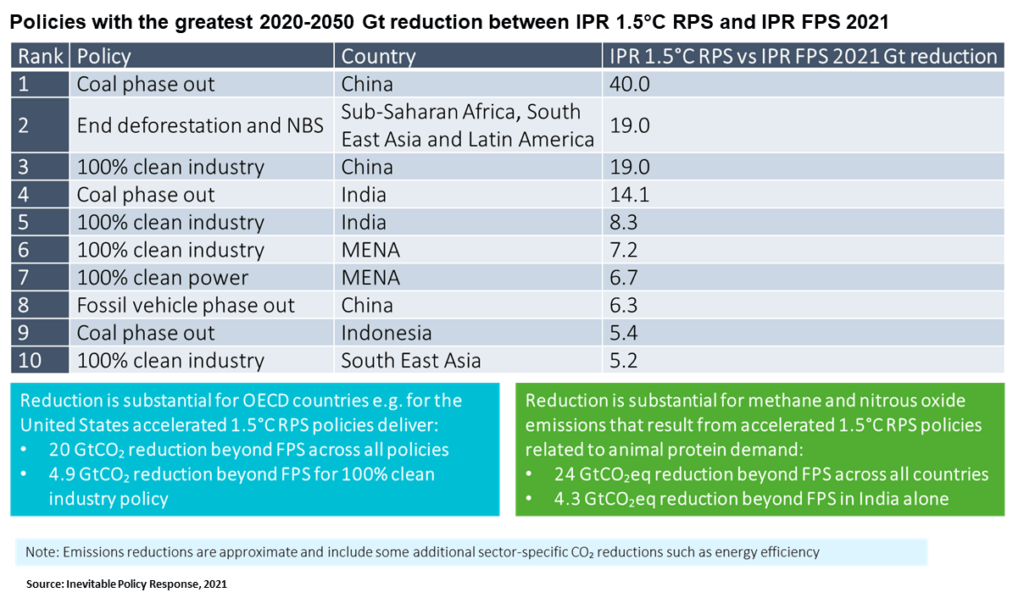
7. Land Use in IPR
IPR builds on the Potsdam Institute for Climate Impact Research MAgPIE model and has developed a Biodiversity module to make detailed Land use estimates of emissions and develop forecasts and technology pathways in this crucial sector, often neglected in climate modelling. The IPR 1.8C FPS is optimistic that deforestation can be ended by 2030 and substantive amounts of Nature Based Solutions can be deployed to remove carbon.
IPR FPS 2021 CO₂ emissions fall from around 40 Gt in 2020 to 8 Gt in 2050, with the land sector becoming a net carbon sink before 2050:
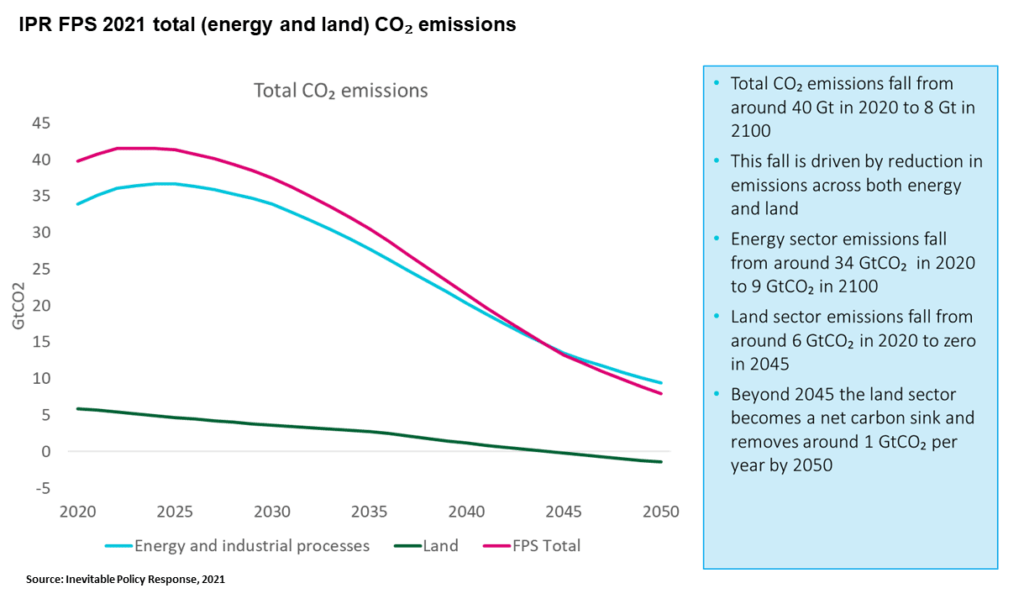
Global removal of GHG with NBS is expected to reach 4.7 GtCO2eq in 2050, with the greatest sequestration potential occurring in China.

The key cross over between energy and land is Bioenergy itself. The 2023 FPS will explore a full bioenergy model in addition to its existing body of work.
8. Carbon budgets are tight
The IPCC in AR6 estimate time frames for carbon budgets at various temperatures. The chart below shows a simplified version of ‘straight line’ carbon budget pathways to get to NET Zero consistent with the temperatures. Time frames are very tight, and the steepness of the pathway is daunting for 1.5C.
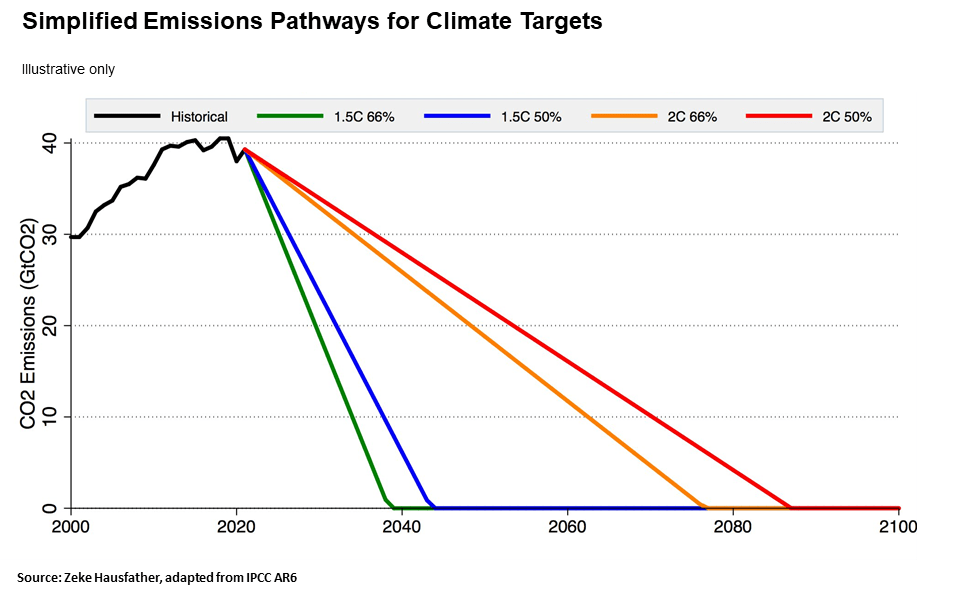
9. Carbon Removals: Policy
Nature Based Solutions remain the key lower cost options for Removals. However, for many years it has been evident that implementation and execution is a big challenge. The recent discussions about Forestry in Voluntary Carbon Markets have again reinforced this. The need for government backed solutions and compliance markets remains crucial.
Since CCS is at the heart of non NBS Removals in terms of directly storing carbon, or CCUS using it, or Bioenergy CCS BECCS in the power sector or the more ambitious Direct Air Capture DACCs, it remains a key technology to prove at scale. Much is written about the lack of that scale currently. More expensive than renewables plus storage at present there is a strong argument it does not need developing for electricity systems. However even there the base load considerations lead to a case for gas peakers with CCS as a backup. When it comes to the two key overshoot Removals technologies – BECCS and DACCS – further policy considerations are certainly required.
The recent US Inflation Reduction Act included realistic incentives for CCS as outlined in Carbon Tracker March 2023 study, ExxonMobil – The Existential Crisis
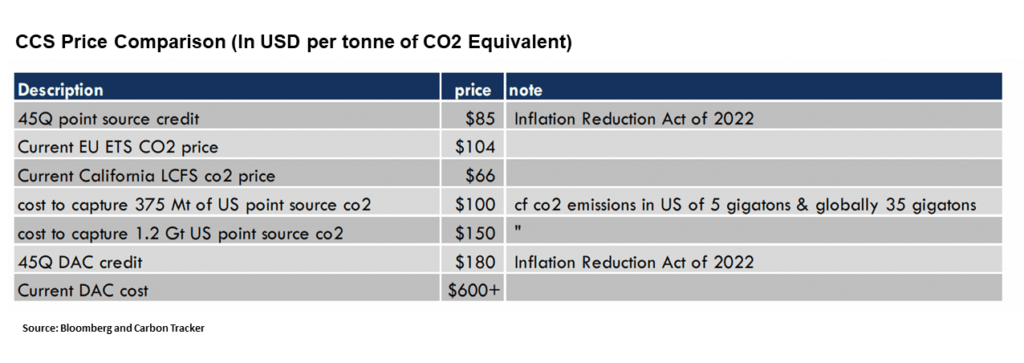
Interestingly a new website has sprung up just to track Carbon Removal policy in the US
10. A possible Carbon Removals portfolio
In 2020 IPR explored this landscape of Carbon Removals under the terminology of Negative Emissions Technologies, NETs. Later this year IPR plans to explore an updated look at this and how investible the sector is.
Overview of carbon removal potential, costs, constraints, and side effects of NETs:
| Technical solutions | |||||
| NET | Sustainable CO2 removal potential per year in 2050 (GtCO2) | Cost in 2050 ($/tCO2) | Constraints | Positive impacts | Negative impacts |
| BECCS | 0.5–5 (0.5–32 (2100)) | 100–200 (15–400) | Land availability; CO2 storage availability | – | Supply chain and LUC emissions; water scarcity; soil depletion; pollution due to fertiliser use; impacts on food supply and land tenure |
| DACCS | 2050: 0.5–5 2100: up to 30 (0.5–30) | 100–300 (30–1,000) | Capital cost; energy demand; material and labour demand for construction; water demand (depends on process) | – | Low CO2 concentrations in local vegetation |
| Nature-based solutions | |||||
| NET | Sustainable CO2 removal potential per year in 2050 (GtCO2) | Cost in 2050 ($/tCO2) | Constraints | Positive impacts | Constraints |
| Afforestation and reforestation | 0.5–3.6 (0.5–17.9) | 5–50 (2–237) | Land competition; water and nutrients requirements | Increases biodiversity (depends on the case) | NOx emissions from nitrogen fertilisers; changes in evapotranspiration, albedo and cloud cover; water scarcity |
| Soil carbon sequestration | 2.9–5.7 (0.4–13) | 0–100 (-45–100) | Sink saturation; land availability | Better soil quality and health; food security | Higher N2O and CH4 emissions and water pollution (limited to a subset of practices |
| Biochar | 0.3–2 (0.03–6.1) | 90–120 (-173–225) | Biomass feedstock availability | Higher yield; lower N2O and CH4 emissions; higher soil’s water balance | Lower albedo and radiative forcing |
| Enhanced weathering | 2–4 (0.2–88) | 50–200 (15–1,000) | Mining, transport, and utilisation of large amounts of minerals; logistical costs | Nutrient source; soil quality | Ecological impacts of mineral extraction and transport |
Mark Fulton, Founder, Inevitable Policy Response
Copyright: Inevitable Policy Response April 2023

